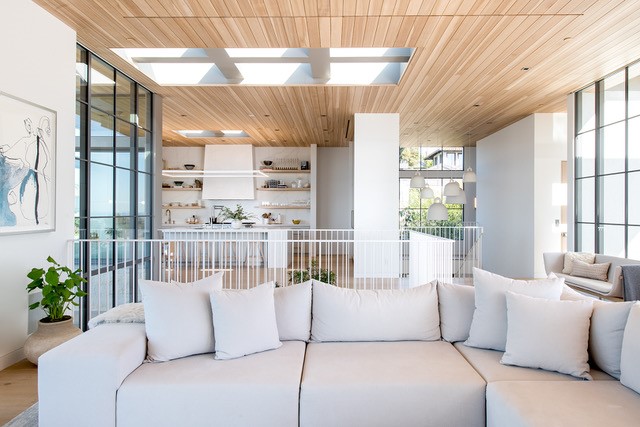
Plant a Tree Inside Your House, or Build Around One. Then Watch It Steal the Show.
Putting a living, growing tree—yes, a full-size, roots-in-the-ground tree—inside your house is a design idea that we can get behind.

Courtesy of Laney LA
When Anthony Laney, a principal and co-founder of the California architecture firm Laney LA was designing a dream house for his client—an artist living in the South Bay—he asked her what kind of first impression she wanted to make in the foyer of her new home. Did she want a large sculpture? A dramatic hanging light fixture? A round table with a few artfully placed objects? He got an answer he wasn’t expecting.
She wanted a tree. Inside, but planted in the ground.
“She wanted people to be arrested by the sight of this 16-foot tree, right when they walk in the door,” Laney says. “She’s passionate about the natural world, and the tree was a symbol of that. She wanted to treat it like it was a sculpture.”

Courtesy of Laney L
Trees have lived indoors—in pots—for as long as trees and pots and houses have existed. (Ancient Romans loved showy rosebushes in marble planters, while the Greeks and Egyptians stuck with simpler terracotta.) But having a mature tree inside of a house, with roots firmly in the ground, is a common tradition only in tropical climates, like Brazil or Cambodia. In Japan, where trees can be considered sacred, interior trees are often one of the only decorations inside a minimalist house. Aside from a few fearless modernists in the United States, most Americans like to draw a firmer boundary between inside and outside. Fear of dirt may be a factor. Or fear of killing said tree, and having a leafless trunk and branches become part of the architecture could also be a contributing influence.
“We brought a few different trees in to the construction site, to see which one would be happiest there,” Laney says, adding that Rob Jones of Jones Landscaping was instrumental when it came to choosing the best specimen, and getting the conditions just right. “Most mature trees need to acclimate to the environment. You just have to consider the light exposure, the humidity levels in the house, and make sure there’s proper ventilation around it.”
Special pavers that allow for circulation around the tree roots, and a motorized skylight that opens up to give the tree fresh air are two accommodations Laney made to make sure the tree—an Australian Brachychiton—welcomes family and visitors from the double-height atrium foyer.
“The house has kind of a reverse footprint, like many do in the area, where you enter on the lower level but the living spaces are on the second floor,” says Laney. “When you walk in and see the tree, your eye is drawn upward, so it gives you a visual cue to look at what’s above you.”
The tree has become part of the household—a living, breathing resident that it has a name: Brachy.
It’s kind of like a pet that doesn’t need to be walked.
Here are other gorgeous ways to incorporate a tree into your dream house.
Alterstudio, an award-winning architecture firm in Austin, Texas has made accommodating old trees—building decking and roofs around them—part of their design calling card.
Katie and Matt Tarses fully enclosed a courtyard to create an interior solarium, which is also their living and dining room, with mature tropical trees growing inside of it.
Residential designer Jeremy Levine, who built the Cowboy Modern retreat in Pioneertown featured by Sunset a few months back, renovated a modern house in Eagle Rock with an interior tree. A sitting room with built-in benches, and a Moroccan-modern look, surround it.
A ficus planted in the main foyer of designer Kelly Wearstler’s Malibu home is two stories high. The skylight above opens to give the tree access to fresh air and unfiltered light.
This Came from the 2021 Waters of the West Issue—Read It Here!
Get one year of Sunset—and all kinds of bonuses—for just $24.95. Subscribe now!
